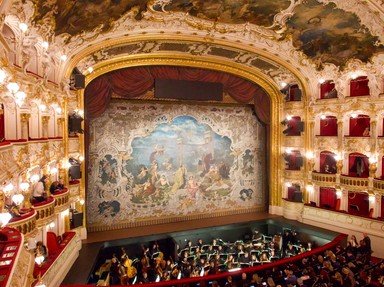Quiz Answer Key and Fun Facts
1. This character of the Commedia dell'Arte is depicted wearing a mask with a large fleshy nose, and a somewhat down at heel, worn or patched military uniform. He proudly carries a sword but would much rather scream and run away than draw it to stand and fight.
Who is he?
2. Known as Kasperle in Austria, Hanswerle in Germany, Toneelgek in The Netherlands, and Karagoz in Turkey, this character of the Commedia dell'Arte represents the poor working man.
He dresses in a baggy white shirt and trousers, with a tall hat, and wears a brown or black mask with a long hooked beak of a nose.
Who is he?
3. Originally a generic character, this female servant girl was first called sobretta, servetta, or fantesca meaning 'little servant girl'.
Later she was known at different times as Franceschina, Smeraldina, Oliva, Nespola, Spinetta, Ricciolina, Corallina, Diamantina, and Lisetta.
Who did she eventually became known as?
4. This character from the Commedia dell'Arte is always fat. If the actor is thin, then padding is used to increase his girth. Dressed in black robes, sometimes with a white ruff, he often carries a book to show he is a learned man.
His mask is half face, to allow his rouged red cheeks to show his fondness for alcohol, and has grey fluffy eyebrows.
Who is this character?
5. One of the characters of the Commedia dell'Arte who is most recognisable today, wears a voluminous white suit with large 'bobbles' down the front, and a large floppy collar. He has a pointed white hat, and instead of a mask, his face is painted white, with black accents, sometimes including a teardrop on his cheek.
This character has several names, which of these is NOT one of them?
6. The Innamorati are the Lovers characters in the Commedia dell'Arte. They are always young and attractive, and often well to do. The Innamorati do not wear masks, or if they do it is a simple vizard of plain black; instead they wear heavy makeup.
How do the Innamorati dress?
7. This Commedia dell'Arte character is portrayed as an older man in the traditional red and black garb of a Venetian merchant. His most (ahem) 'outstanding' feature is a large phallic codpiece, alongside which he hangs his money pouch.
Who is he?
8. The Zanni of the Commedia dell'Arte are the clowns. The name is a diminutive of Giovanni, and the characters are representative of the Bergamase peasant migrant workers of the 16th Century who "moved to the city" to look for work.
Would you recognise a Zanni by his traditional costume - how are they dressed?
9. The name of one prop first used in the Commedia dell'Arte has passed into modern usage as the term for a type of comedy typified by the work of Laurel and Hardy, Buster Keaton, and The Three Stooges.
Made of wood, in Italian it is called a battachio. What is this called in English?
10. This character of the Commedia dell'Arte evolved from being a minor member of the zanni in the early 17th Century, to being a major romantic figure 100 years later.
By the 18th Century his costume had become the familiar diamond patchwork in bright primary colours that we know today.
He wears a black mask and is never seen without his battachio.
Who is he?
Source: Author
Rowena8482
This quiz was reviewed by FunTrivia editor
agony before going online.
Any errors found in FunTrivia content are routinely corrected through our feedback system.


